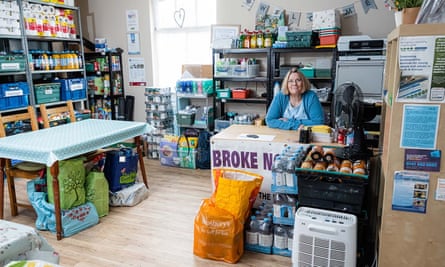This time last year, Sarah (not her real name) was a regular donor to the food bank drop-off point outside her local Sainsbury’s. But in March 2021 she had to stop. Despite working full-time and being on universal credit, the mother of two has for the past few months had to rely on food banks. “I have gone from being an average working-class citizen to somebody who’s in poverty,” said the 44-year-old Londoner.
She is one of a growing number of former donors who, food aid workers report, are now turning to food banks themselves as the soaring cost of living expands the demographic of people struggling to afford food.
“It’s so distressing to see the numbers of people coming who have never been in this position before,” said Sabine Goodwin of Independent Food Aid Network. “We’re seeing people who hadn’t even had to contemplate using a food bank, who might have been donating to a food bank this time last year. And it’s happening in every part of the country.”
A Food Standards Agency survey published last month found that between April and June last year, 15% of people in England, Wales and Northern Ireland were food insecure (which means they were facing either reduced quality, variety or desirability of diet, or disrupted eating patterns and reduced food intake) and 4% reported visiting a food bank in the past 12 months.
But the numbers are believed to have grown considerably. Research by poverty charity Turn2us found that four in 10 of those on universal credit – about 2.5 million people – would be unable to afford food after the axing in October of the £20 uplift.
Sarah’s journey to poverty started when the breakdown of her 20-year relationship led to her moving out of her family home in March. But the soaring cost of food and fuel combined with rent, her share of childcare costs, and October’s universal credit cut, meant she was soon struggling to make ends meet. Now she thinks of going to the dentist as an unaffordable luxury, cannot afford after-school clubs for her teenage children and avoids turning the heating on. Without access to a food bank, she said, “my options would be just bread and butter, really. I would be going hungry”.
When she first visited the food bank in June, she was ashamed. “I felt like ‘should I really be here? Am I in need enough?’ It was a really bad feeling. But luckily the team there were amazing and put me at ease very quickly.”
Even with food banks, she still struggles to get enough to eat. “You really have to be mindful what you buy because you can’t get everything from the food bank.”
Sarah, who now also volunteers at a food bank, said there should be more walk-in hubs offering food along with advice on the “too complicated” benefits system.
As well as looming energy price rises, Sarah also faces moving flat and paying more rent. “I don’t know what I’m going to do,” she sighs. “It’s so mega expensive.”
Demand for food banks had been growing since the start of the pandemic, but in recent months, numbers have grown exponentially. Charlotte White, manager of Earlsfield food bank in south-west London, said those relying on them have increased from 25-30 people a week to well over 100 households. “We’re terrified by what we’re seeing,” she said. “In the past two months it has gone crazy, in terms of the volume we’re seeing, but also the complexity of the problems and issues people are coming in with.”
Former food bank donors, volunteers and support workers are turning to them, as are growing numbers of families and, for the first time, people with mortgages. “People will say, ‘I used to give to food banks and now I need you.’ We have also had some of our volunteers saying, ‘Could I take a bag today? Is that OK?’.”
As many as 50% of the people Earlsfield helps are in work. “The guests we’ve seen for a long time are suffering more than ever, and we have this whole load of new guests needing us for the first time.”
Paul O’Brien of social justice charity Micah Liverpool has seen the use of its food bank grow steadily since the universal credit cut. He predicts another influx of new registrations from April, when fuel prices rise.
He wants more action from the government. “There are only so many food banks,” he said. “The pressure on the third sector is just too great.”
Broke Not Broken, which runs a food bank in Perth and Kinross, has doubled its opening hours to meet demand and is helping more working people – including families with two working parents.

“Before Covid, the reason most people used us was benefit sanctions. That’s not the case now,” said Annie McCormack, the charity’s chair. “Now pretty much every referral is here because of low incomes, or because they’re waiting to be moved on to universal credit, which takes a minimum of five weeks.”
She worries how her small charity will survive. “We need to think seriously about how we continue. It’s a challenging question because we need more and more volunteers to be able to deliver parcels. Last April, we thought we could see the light at the end of the tunnel. The tunnel is never-ending now.”
